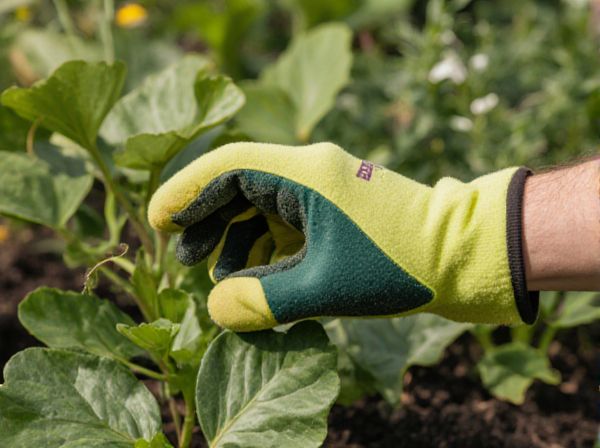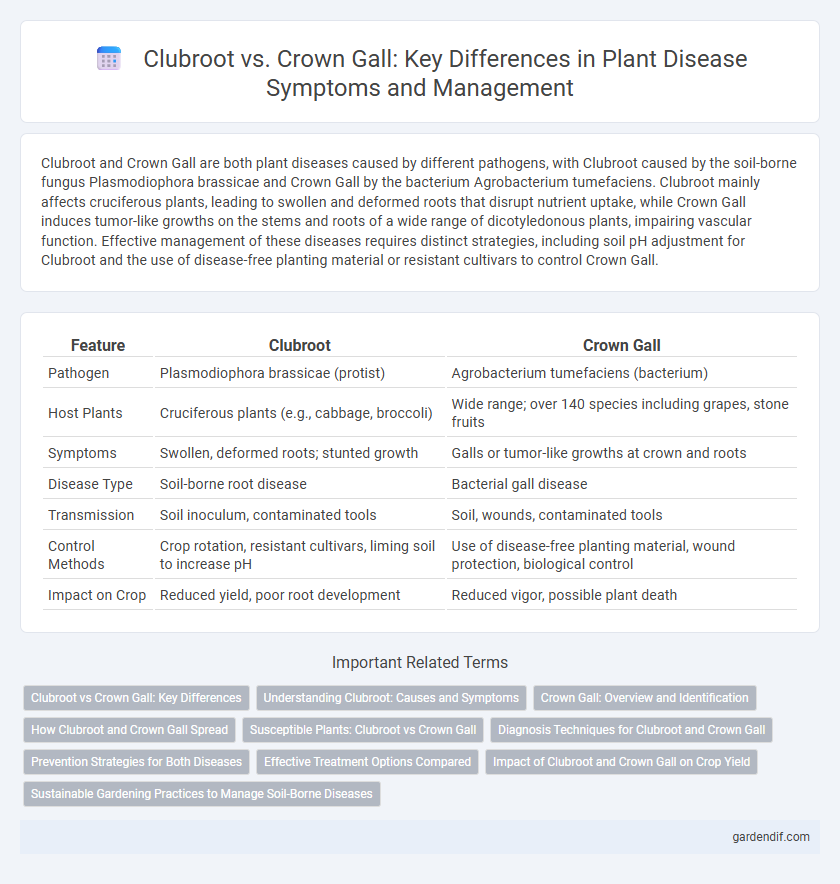
Clubroot vs Crown Gall Illustration
Clubroot and Crown Gall are both plant diseases caused by different pathogens, with Clubroot caused by the soil-borne fungus Plasmodiophora brassicae and Crown Gall by the bacterium Agrobacterium tumefaciens. Clubroot mainly affects cruciferous plants, leading to swollen and deformed roots that disrupt nutrient uptake, while Crown Gall induces tumor-like growths on the stems and roots of a wide range of dicotyledonous plants, impairing vascular function. Effective management of these diseases requires distinct strategies, including soil pH adjustment for Clubroot and the use of disease-free planting material or resistant cultivars to control Crown Gall.
Table of Comparison
| Feature | Clubroot | Crown Gall |
|---|---|---|
| Pathogen | Plasmodiophora brassicae (protist) | Agrobacterium tumefaciens (bacterium) |
| Host Plants | Cruciferous plants (e.g., cabbage, broccoli) | Wide range; over 140 species including grapes, stone fruits |
| Symptoms | Swollen, deformed roots; stunted growth | Galls or tumor-like growths at crown and roots |
| Disease Type | Soil-borne root disease | Bacterial gall disease |
| Transmission | Soil inoculum, contaminated tools | Soil, wounds, contaminated tools |
| Control Methods | Crop rotation, resistant cultivars, liming soil to increase pH | Use of disease-free planting material, wound protection, biological control |
| Impact on Crop | Reduced yield, poor root development | Reduced vigor, possible plant death |
Clubroot vs Crown Gall: Key Differences
Clubroot, caused by the soil-borne pathogen Plasmodiophora brassicae, primarily affects cruciferous plants by inducing swollen, tumor-like galls on roots, leading to nutrient uptake disruption and stunted growth. Crown Gall, caused by the bacterium Agrobacterium tumefaciens, creates rough, woody galls at the crown or roots of various plants, severely impacting vascular function and water transport. The key differences lie in their causative agents (protist vs bacterium), symptom locations (root swelling vs crown/root galls), and host specificity, with Clubroot targeting brassicas and Crown Gall having a broader host range.
Understanding Clubroot: Causes and Symptoms
Clubroot is a soil-borne disease caused by the pathogen Plasmodiophora brassicae, primarily affecting cruciferous plants such as cabbage and broccoli. It induces swollen, deformed roots that disrupt nutrient and water uptake, leading to wilting, stunted growth, and yellowing of leaves. Unlike Crown Gall, which results from Agrobacterium tumefaciens infection causing tumor-like galls at the crown and stems, Clubroot's root galling specifically interferes with root function and plant vitality.
Crown Gall: Overview and Identification
Crown Gall is a plant disease caused by the soil-borne bacterium Agrobacterium tumefaciens, characterized by tumor-like galls typically found at the crown or roots of affected plants. These galls disrupt nutrient and water uptake, leading to stunted growth, wilting, and reduced productivity in crops such as grapes, stone fruits, and roses. Identification involves observing swollen, rough, and irregular galls near the plant base, often confirmed by bacterial isolation or molecular diagnostic techniques targeting the virulence genes of Agrobacterium tumefaciens.
How Clubroot and Crown Gall Spread
Clubroot spreads primarily through contaminated soil, water, and infected plant debris, with the pathogen Plasmodiophora brassicae producing resilient resting spores that can persist in soil for years. Crown Gall is caused by the bacterium Agrobacterium tumefaciens, which spreads via wounds on plant roots or stems, often transmitted through contaminated tools, nursery stock, and insect vectors. Both diseases rely on environmental factors and human activities for dissemination, making hygiene and proper cultural practices essential for management.
Susceptible Plants: Clubroot vs Crown Gall
Clubroot primarily affects cruciferous plants such as cabbage, broccoli, and cauliflower, causing root swelling and deformation. Crown Gall targets a broad range of woody and herbaceous plants, including grapes, stone fruits, and roses, characterized by tumor-like growths at the plant crown or roots. Susceptibility in crucifers is linked to Plasmodiophora brassicae, whereas Agrobacterium tumefaciens causes crown gall in diverse hosts.
Diagnosis Techniques for Clubroot and Crown Gall
Diagnosis techniques for clubroot primarily involve soil bioassays, microscopic examination of root galls, and polymerase chain reaction (PCR) tests to detect Plasmodiophora brassicae DNA. Crown gall diagnosis relies on visual inspection of tumor-like growths on stems and roots combined with bacterial isolation and identification of Agrobacterium tumefaciens through molecular methods such as PCR and sequencing. Accurate differentiation between clubroot and crown gall ensures targeted management strategies and reduces crop losses in affected plants.
Prevention Strategies for Both Diseases
Clubroot prevention relies on crop rotation with non-host species, liming to raise soil pH above 7.2, and resistant cultivars to reduce Plasmodiophora brassicae infection. Crown gall control involves using disease-free planting material, applying biological control agents like Agrobacterium radiobacter strain K84, and avoiding wounding to minimize Agrobacterium tumefaciens entry. Both diseases benefit from sanitation practices and monitoring soil conditions to limit pathogen survival and spread.
Effective Treatment Options Compared
Effective treatment options for clubroot primarily involve soil liming to raise pH levels above 7.2, crop rotation with non-host plants, and the use of resistant cultivars to minimize pathogen impact. In contrast, crown gall control focuses on preventing wounds and using biological antagonists such as Agrobacterium radiobacter strain K84, which inhibits tumor formation. Both diseases benefit from integrated management practices, but their distinct pathogen biology necessitates different soil and host management strategies for effective control.
Impact of Clubroot and Crown Gall on Crop Yield
Clubroot, caused by Plasmodiophora brassicae, significantly reduces crop yield in brassica crops by damaging root systems and impairing nutrient uptake, often resulting in yield losses up to 50%. Crown Gall, triggered by Agrobacterium tumefaciens, causes tumor-like galls on roots and stems, restricting nutrient flow and reducing yield, particularly in fruit and woody plants. The severity of both diseases depends on environmental conditions and crop susceptibility, with clubroot generally causing more extensive long-term yield decline in affected fields.
Sustainable Gardening Practices to Manage Soil-Borne Diseases
Managing clubroot and crown gall effectively in sustainable gardening involves crop rotation and soil pH adjustment, especially raising pH above 7.2 to inhibit Plasmodiophora brassicae responsible for clubroot. Employing disease-resistant plant varieties and utilizing biological controls like beneficial microbes can reduce Agrobacterium tumefaciens impact, the pathogen causing crown gall. Incorporating organic matter and maintaining proper soil drainage enhances microbial diversity and soil health, limiting soil-borne disease proliferation.
Clubroot vs Crown Gall Infographic

 gardendif.com
gardendif.com